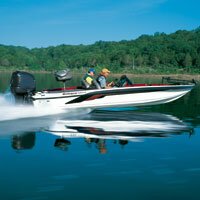Muskellunge
Esox masquinong
AKA: Muskie, tiger muskie (hybrid species)
Distinguishing Markings:
In general, identifying the hybrid tiger muskie from the muskellunge is fairly easy, though it can be more difficult with some individuals. The tiger muskie is named for the prominent light-colored, branching bars on a dark blue-green background, with some of the light-colored pattern continuing across the back. Muskellunge have much less prominent, non-branching, dark bars on an olive to tan background with no pattern across the back. Tiger muskie generally have five or six chin pores located on the right and left bottom surface of the lower jaw, while muskellunge will usually have as many as 10 per side.
Size:
The muskellunge, or muskie as it is commonly called, is one of the largest freshwater game fish in North America. A full-grown muskie can exceed 30 pounds.
Distribution:
Muskies have appetites to match—or exceed-- northern pike and a similar distribution.
Habitat:
Muskellunge and tiger muskie use a variety of habitats seasonally from deep open water to shallow cover such as weeds and fallen trees. In rivers, they usually occupy the deeper pools with reduced current.
Food:
Muskellunge are opportunistic ambush predators, feeding primarily on other fish. Unlike sharks, muskies’ teeth do not mesh to take bites, but are used to hold their prey, which they must swallow whole. Muskellunge prefer to prey on large, soft-finned species such as suckers, fallfish, minnows, and small carp. Due to their size and their ability to prey on fish up to forty-five percent of their own length, muskies occupy a unique environmental niche.
Spawning:
Muskellunge begin spawning in April or May when water temperatures exceed 50°F for several consecutive days. Tiger muskie are sterile hybrids and do not reproduce. Spawning takes place near aquatic vegetation, debris, and leaf litter over a period of a few days. The eggs are broadcast over a fairly large area and settle to the bottom, without any parental care. Surviving eggs hatch in about two weeks.
Muskies grow very rapidly reaching approximately twelve inches by the end of their first growing season, 24 inches by the end of the second, 30 inches by the end of their third, and 36 inches during their fifth or sixth season. Females grow faster and live longer than males; the maximum lifespan can be as much as 25 to 30years.
Fishing Tips:
Tackle for muskie needs to be stouter than tackle used for bass and walleye; typically, a medium-heavy action casting rod with twenty pound test monofilament or braided line. Use a hard monofilament or wire leader to prevent the line being cut by their teeth. Large crank baits imitating suckers and fallfish and bucktail spinners are popular lures for muskie, but anglers not familiar with handling these fish may want to stick with single-hook lures such as spinnerbaits to start with. You will also need several tools to make releasing muskies safer for both the fish and the fishermen. Foremost is a large needle-nose pliers or a hook-out (pistol grip pliers) for removing hooks while keeping fingers a safe distance away from their teeth.
See Also:
- Secret Fishing Tips
- Bass Fishing Tips - 10 Bass Fishing Secrets from the Pros
- 27 Ways To Tell If You’re A Fishing Fanatic
- Trolling Motors
- When To Fish
- Fighting A Fish
- Freshwater Fishing Tips
- Codes of Angling Ethics
- Freshwater Fishing Basics
- Fishing With Kids
- Where Do Fish Live?
- Discover Fishing
- Fishing Tips - Rod Storage
- Fly Fishing Boats
- What’cha Eating? Bait Matrix
- Flyfishing Essentials
- Freshwater Fish - Bass
- Ten Tips for Clean and Green Boating
- Finding the Right Freshwater Fishing Boat for You
- Freshwater Fish - Trout
- Freshwater Fish - Crappie
- Freshwater Fish - Northern Pike
- Fishing Accessories - Tips from the Boating Guy
- Freshwater Fish - Perch
- Choosing the Most Effective Freshwater Fishing Tactics
- Freshwater Fish - Catfish
- Freshwater Fish - Carp
- Selecting Your Freshwater Fishing Gear
- Freshwater Fish - Chain Pickerel
- Freshwater Fish - Walleye
- Freshwater Fish - Eel
- Freshwater Fish - Muskellunge
- Freshwater Fish - Drum
- Boating is Affordable

